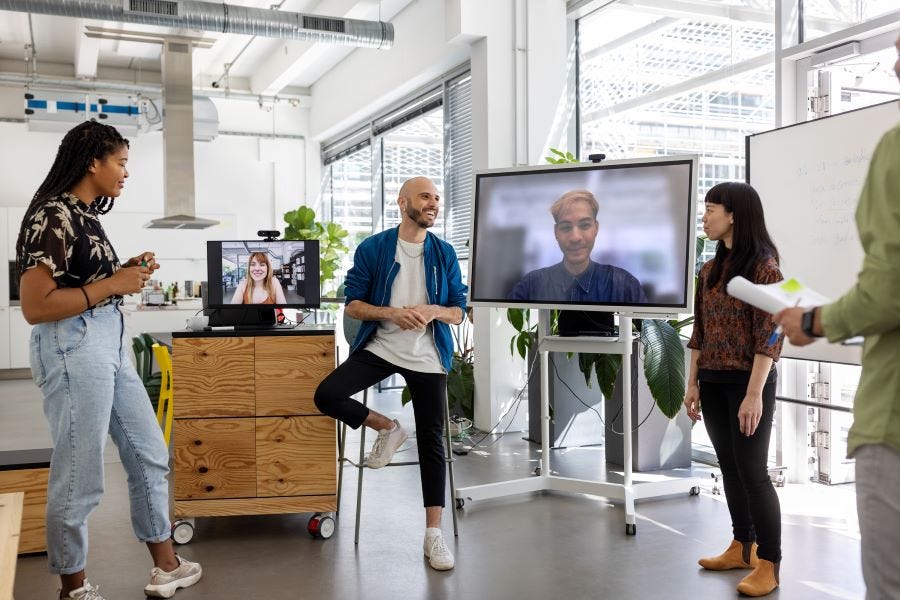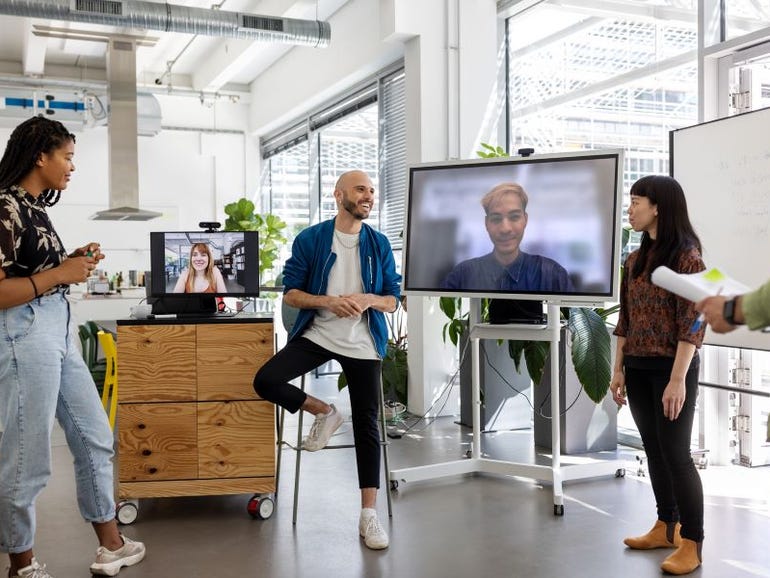The future of work: How everything changed and what’s coming next

Image: Luis Alvarez
The future of work has dominated discussions both in the office and at home. What was previously ‘the great remote working experiment’ has now morphed into ‘the great hybrid work pilot’ and even ‘the great resignation’ as companies shake up their workplace policies to align with a new, employee-led work landscape, and employees decide whether they like what they see.
According to a January 2022 Future Forum Pulse Survey of more than 10,700 knowledge workers, hybrid working – which combines remote working with days based in an office – has become the dominant model of work.
The survey found that hybrid work arrangements increased 12 percentage points between May and November of 2021, rising from 46% to 58%. Half of respondents said their company offered flexible working hours, while 42% offer flexibility in working location. As employees settle into the new way of working, employee experience scores also appear to have improved, with Future Forum finding that hybrid and remote employees scored better on work-life balance, stress and work satisfaction than those that were required to work from the office full-time.
Working from wherever, whenever, forever
This brings us to what is perhaps the most prominent question looming over the future of work: the role of the office. What was once the mandated location for desk-bound employees to put in their nine-to-fives is no longer universally viewed as the epicentre of the professional world – particularly within the tech industry.
Research carried out by the Office for National Statistics (ONS) in June 2021 found that just 15% of the information and communication industry expected 75% or more of their workforce at “their normal place of work” – i.e., the office – in the future. This is compared to 49% of the accommodation and food service industry, and nearly two-fifths (38%) of businesses across all industries.
It’s little surprise that IT and knowledge workers are most likely to feel that remote working is here to stay: given that their roles may require nothing more than a computer and a broadband connection, knowledge workers see little value in commuting elsewhere to do a job they could quite as easily perform at home.
What is more interesting is what this mean for businesses’ corporate real estate investments. Companies – and big tech companies in particular – have funnelled billions of dollars into building fantastical workspaces designed to attract talent and serve as a physical reflection of their brand, values and corporate identity. With more employees now showing a preference towards remote and hybrid work, there is likely some concern amongst CFOs about whether these investments will continue to pay off.
Certainly, in major tech hubs, a renewed interest from tech companies in broadening their search for talent beyond metro areas could be weakening the demand for office real space.
Data from the Office of the New York State Comptroller’s Office shows that, while office leasing activity has rebounded since the shift to remote working in 2020, the total market value of office buildings in New York City dropped by $28.6 billion in FY 2022 – the first decline in more than 20 years. This is being driven by lower demand, which has left office complexes vacant, and rental prices weak.
“The new and prolonged remote work arrangements have raised questions about the future of office space. Employers are assessing how they use shared office space while considering shifts in worker preferences and the feasibility of long-term remote work,” said the report.
“Some businesses have already instituted permanent hybrid remote-work arrangements, and others are contemplating similar plans. As these developments unfold, the future of office real estate is largely uncertain.”
A number of companies have signalled that they were moving to a remote-first model, including Salesforce and Spotify. In the UK, bank HSBC announced in 2021 that it would cut its office space by 40% in a move to embrace hybrid work, with fellow banks Santander and Nationwide also closing branches and re-thinking workspaces in a nod towards new working styles – suggesting that the role of the workplace very much remains in a state of flux.
It may upset managers who have lived their professional behind a desk, but in this new, more liberated world of work, it is now workers who are in the driving seat: and those workers are more willing than ever to vote with their feet if employers refuse to embrace flexibility.
An Ipsos survey of 12,500 workers in July 2021 found that 30% would be prepared to quit their job if their employer made them go back to the office full-time. Meanwhile, research by Microsoft and YouGov in December 2021 found that more than half (51%) of UK workers would consider leaving their company if hybrid working was axed.
This should sound alarm bells for any organization that is struggling to hire or retain key tech workers, or the fill skills gaps required to keep businesses competitive in a software-driven world. Appetite for remote working remains high among developers who want more flexibility and a better work-life balance in their careers, with tech and IT workers increasingly realizing that they do not have to relocate for well-paid and rewarding jobs.
Terminal’s 2022 State of Remote Engineering Report of 1,000 developers found that 75% of developers want to work remotely at least three days a week, with 68% saying they are able to get more meaningful work done while working remotely or from home.
Likewise, a March survey of more than 2,000 software engineers by Hired found that developers increasingly prioritize employment that promotes healthy work-life balance and a flexible routine that’s not centred around the office, with the report warning that employers need to embrace flexibility more broadly and give employees with “the freedom to manage their own time and work schedule without the confines of the strict 9-5.”
Analyst Forrester notes that the IT workforce was suffering a talent shortage long before the pandemic, and with many companies now adopting work-from-anywhere policies, these highly prized professionals have grasped the opportunity to negotiate for fully remote work arrangements, better working conditions, more development opportunities, and higher wages.
“Because tech workers aren’t typically constrained by industry, the already-hot job market became even more competitive,” Forrester said in its March 2022 report, Unpacking The Hype About The Great Resignation.
“Companies with poor EX practices or limited flexible work options have seen a talent drain; those with more mature talent practices have been able to attract and retain high-value talent”.
Long live the office. Wait, what?
Just because more employees are choosing to work from home, cafes, shared workspaces and wherever else they so choose, this is not to say that the office is done.
KPMG’s 2021 CEO Outlook Pulse Survey noted that, rather than downsizing their physical footprint, companies are continuing to occupy the same spaces and are instead reimagining their function and purpose. For example, instead of rows upon rows of desks, they are reimagining what the workplace looks like and how it can better align with the needs of employees, says KPMG’s Mel Newton. This involves designing spaces that encourage colleagues to drop in to collaborate and share ideas, which means an emphasis on open space, breakout areas and meeting rooms equipped with modern videoconferencing tech.
Some companies have taken this even further: with work-life balance and stress among the top complaints of office-based workers, some companies have been experimenting with social, fitness and wellness incentives, spanning the quirkiness gamut from yoga and meditation classes to fully-stocked cocktail bars and stationary bike ‘desks’.
It’s not just where work will be done in the future – it’s when. The 9-5 model was created at a time when most workers were employed on assembly lines and long before technology allowed us to communicate with anyone, anywhere in the world at any time. And yet, we still allow work to take up the best hours of our day – second to our own personal needs and social obligations.
The 2022 Future Forum Pulse survey found that 95% of workers want flexibility around when they work. Working parents are four to five percentage points more likely than non-parents to prefer no schedule constraints, as this flexibility allows them to fit caregiving duties into their working days. Working mothers are 16% more likely than female knowledge workers with no children to prefer total schedule flexibility, the survey found.
Flexible working arrangements like part-time and compressed hours and flexible scheduling stand to benefit both employers and employees. An April 2021 report by the Chartered Institute of Personnel and Development (CIPD) found that flexible working not only brings direct business benefits by reducing office space requirements and increasing the available talent pool, but also brings less tangible benefits in the form of happier, more engaged employees; reducing absence rates and helping with workers’ mental health and stress.
Living for the (three-day) weekend
An even more progressive idea for tipping the work-life balance in favour of employees is the four-day workweek. A pioneering five-year study in Iceland found that slashing employees’ weekly hours led to higher productivity and wellbeing amongst workers, and conversely, reduced rates of stress and burnout. Following the success of the trial, some 86% of Icelandic workers are either working shorter weeks, or have the option to request such an arrangement.
The argument for a shorter working week is strong – happier workers are typically more productive and engaged in the workplace, meanwhile the potential mental health and wellbeing benefits of a more even split between work and leisure time are huge. A March 2022 study by Henley Business School found that businesses who have moved to a four-day workweek are saving £104 billion, or around 2.2% of total turnover, through productivity gains and the talent it helps them attract. Some 65% of UK businesses surveyed said they are planning or have implemented a four-day working week for some or all of their staff.
Iceland’s trial has caught the attention of other nations, including Spain and Sweden. When Microsoft trialled a four-day week in its Japan office, productivity went up by 40%. It also found that electricity costs fell by 23% that workers printed almost 60% less when they took Fridays off.
In Ireland, 20 companies are currently piloting a four-day week as part of a six-month trial that is running in conjunction with similar pilots in Canada, the US and the UK. Whether such a radical rethinking of work will take hold in the long term is uncertain: despite the perceived benefits, history tells us that tradition is hard to break – no matter how outdated.
The future of work
Looking back to 2020, it’s difficult to fathom how much has changed since Covid forced millions of people into remote work and sparked office-weary employees to question whether they would ever need to go back to the office at all. In many cases, the answer was yes – it turns out we humans don’t do too well when we’re confined to house arrest and forced to work from corners, cubbyholes and kitchen tables for the good part of two years, and many of us have since come to value the face-to-face time with colleagues that can boost collaboration and creative thinking when our ingenuity has otherwise failed us.
But it is also true that the office as we have known has become antiquated, and our deep-set notions of how work should fit into our lives have changed radically. The business world did not grind to a halt the moment that our places of work shuttered their doors and sent employees home with a laptop and fistful of stationary. Our professional relationships did not fall into utter and irreparable disarray when we were forced to communicate with co-workers via video calls and instant messaging. Our relationship with work and our colleagues was stress-tested to the extreme, but it also taught us that a better future of work is possible – provided employers are willing to take a leap of faith and commit themselves to change.





Pingback: YOURURL.com